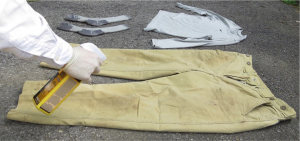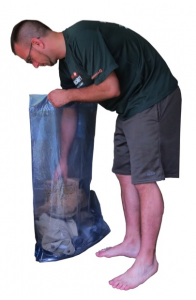These days if you live near anything green — a suburban development, however humble or high-class; a neighborhood park where shrubs and meadow flowers grow — best you’d read up on ticks, be they black-legged ticks (aka deer ticks) or lone-star ticks (so named for the silvery white dot on the female’s back). While you’re at it, read up on Lyme disease and its suite of co-infections, some nastier even than Lyme.
And know this: no magic spray or treatment will eliminate ticks.
Researchers are investigating area-wide tick management options (The Tick Project) and working to understand how habitat management (The Tick Management Handbook; Japanese Barberry Control Methods) and host management (mice, deer) affect tick populations. But it’s up to you to protect yourself — knowing that prevention is the best cure.
- Wear tick-killing clothing. Buy over-the-counter permethrin spray and spray it on your clothing and gear. Used according to the label, permethrin binds to the material and can kill ticks, mosquitoes and other pests following a lethal exposure. Do-it-yourself treatments can remain effective for up to seven washes. Also consider buying pretreated cloths or sending your outdoor socks, pants, and shirts for professional treatments. These can be protected for up to 70 washes.

Follow label instructions for do-it-yourself clothing treatments. - Use repellants. DEET, picaridin, oil of lemon eucalyptus and IR3535 all repel ticks. The percentage of active ingredient on the label indicates how long that product will be active in the field. For more on choosing the right repellant see our previous post, “Understanding over-the-counter sprays for mosquitoes and ticks” (June 2, 2015) and this guide from Consumers Reports.
-

Ticks wait for a passing host on vegetation or in leaf litter. Staying on trails can reduce your exposure to ticks. Recognize and avoid tick habitat.Tick species differ in where they prefer to hang out. The blacklegged tick (transmits Lyme disease) is found at adult knee-height and below in wooded or brushy areas. When hiking, stay on the trail and away from these areas. If you’ll be in tick habitat, take precautions by wearing long pants tucked into your socks and a light-colored shirt tucked into pants. These steps make it more difficult for ticks to get to your skin. If you’ve treated your clothing with permethrin, this can also increase the exposure of the ticks to the acaracide — the tick-killing substance.
- Steer clear of hitchhikers.

Isolate exposed items in large, zippered plastic bags to avoid bringing ticks indoors. Ticks can be carried on clothing or gear that you used outdoors — gear that you haven’t used permethrin or a repellent on. True, ticks don’t survive long in most homes because of low humidity, but still — you’re safest if you change your clothes and place exposed items in a large, zippered plastic bag in an entryway. Put them in a clothes dryer and run on high heat for 20 minutes. The tumbling action of the dryer and the high heat kill ticks and similar critters. [Note: don’t wash clothes first. Even the hottest cycle might not kill ticks, and it increases the drying time needed.]
- Check for ticks. Taking all these steps doesn’t mean you will avoid ticks 100% of the time. Perform daily tick checks even if you haven’t been outdoors in a day or so. Get to know the marks on your skin and recognize new ones. New marks that, if you touch them, just happen to have legs.
- Remove ticks safely. Only one method has been officially evaluated for its ability to safely remove ticks — using sharp tweezers, grab a tick as close to the skin as possible and gently pull up. Other methods could increase the risk of acquiring a tick-borne disease. To learn more, see our post “It’s tick season. Put away the matches.”
- Protect your pets.

Grooming after outdoor activity with a fine-toothed brush can remove ticks in pet fur. Just like people, pets can encounter ticks and acquire tick-borne disease. If your pet goes outdoors, it should have some protection against ticks. TickEncounter describes some of the options available for your pets, including oral and spot-on medications as well as collars. Speak to your veterinarian about the best option for protecting your pet against tick bites. Regular grooming with a fine-tooth comb after being outdoors can help to remove ticks that have not attached to your pet’s skin.
Additional Resources:
What’s Bugging You? tick page
Other tick-related posts